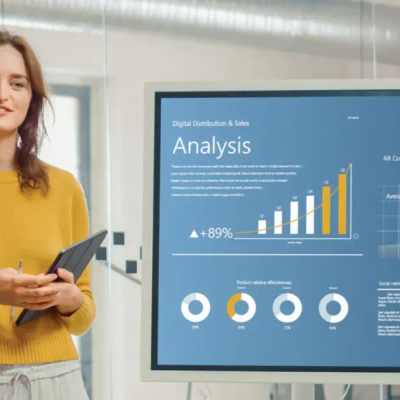Presentations are a crucial component of senior-level interviews, offering you the opportunity to showcase your expertise, leadership skills, and suitability for the role. However, delivering a compelling presentation requires careful planning, effective communication, and confident delivery.
In this guide, we will explore strategies and best practices for creating and delivering impactful presentations that leave a lasting impression on interviewers.
Understand the Audience and Objective
Before diving into presentation creation, take the time to understand your audience – the interview panel – and the objective of your presentation.
What are the key messages you want to convey?
What are the interviewers looking for in a candidate?
Tailor your presentation content and style to align with these expectations, ensuring relevance and engagement throughout.
Structure Your Presentation
A well-structured presentation follows a clear and logical flow, try to think of it like storytelling, guiding the audience through your key points effectively. Consider adopting the following structure:
Introduction: Start with a strong opening to grab the audience's attention and provide an overview of what to expect.
Main Body: Organise your content into distinct sections or themes, each supported by relevant examples, data, or anecdotes.
Questions: Before you summarise, structure the presentation to allow questions before you summarise your main points.
Conclusion: Summarise your main points and reiterate your key messages, leaving a lasting impression on your audience.
Apply the Pyramid Principle
The Pyramid Principle offers a structured approach to communication, emphasising the importance of starting with your main point and progressively building upon it with key arguments and supporting details. By beginning with the most critical information upfront, followed by a hierarchical arrangement of supporting content, this method ensures clarity, coherence, and impact in your communication.

Source: Analyst Academy
Rather than requiring the listener to deduce your main point as you progress, the Pyramid Principle enables you to present the main idea upfront, ensuring that subsequent information is interpreted within the appropriate context.
Keep it Concise and Relevant
Senior-level professionals often have limited time, so it is essential to keep your presentation concise and focused. Avoid overwhelming your interviewers with excessive information or irrelevant details. Instead, prioritise key insights and highlight your most significant achievements and experiences that demonstrate your suitability for the role.
Utilise Visual Aids Effectively
Visual aids such as slides can enhance the impact of your presentation and help reinforce key messages. When creating slides:
Keep them visually appealing and professional, using consistent branding and formatting.
Use words and visuals sparingly to complement your spoken words rather than overpowering them.
Include charts, graphs, and images to illustrate complex concepts and data effectively.
Choosing the right charts
If you are including charts in your presentation, choosing the right ones is significant in delivering a key message. Here are the best practices for graphs:
Bar Chart: Use this when you’re trying to show how categories compare with each other. For example, if you want to compare sales between two different categories.
Line Chart: This chart is well used for showing changes over time. It is particularly useful for changes that do not reset after each period, for example, the number of personnel you will need to hire or the number of employees you will need.
Pie Chart: Use this when you’re trying to compare a category or group of categories with the total (e.g. 80% of growth will come from this revenue stream). Do not use this to compare the categories with each other.
Column Chart: This is also good for comparing categories but is best when comparing these categories over time (e.g. compare sales between years)
Scatter Plot: Use this chart to show the correlation between two variables. For example, show that higher retention is correlated with higher investment in learning and development.
Source: Analyst Academy
Proofread the final presentation and give it a professional name
Proofreading the final presentation is crucial to ensure accuracy, clarity, and professionalism. It helps to catch any errors, typos, or inconsistencies that may detract from the overall quality of the presentation and undermine its effectiveness.
Additionally, giving the presentation a professional name adds to its credibility and sets the tone for a polished delivery. A well-proofread presentation with a professional title reflects attention to detail, thoroughness, and respect for the audience, ultimately enhancing the presenter's reputation and fostering a positive impression.
Practice, Practice, Practice
Practice is key to delivering a polished and confident presentation. Rehearse it multiple times, focusing on your delivery, pacing, and body language. Pay attention to your tone of voice, eye contact, and posture, aiming for a confident and engaging delivery style.
Anticipate Questions and Prepare Responses
You will have created a point in the presentation for questions from your interviews, but you also need to be prepared to address questions from the interview panel throughout. Anticipate potential questions based on your presentation content and rehearse concise and confident responses. Demonstrating your knowledge and expertise through well-articulated answers can further reinforce your suitability for the role.
Seek Feedback and Iterate
After delivering your presentation, solicit feedback from trusted colleagues or mentors to identify areas for improvement. Reflect on your performance and consider how you can refine your presentation skills for future opportunities. Continuous learning and refinement are essential for mastering the art of presentations.
Final thoughts
Mastering presentations is a valuable skill for senior-level professionals, particularly during the interview process. By understanding your audience, structuring your presentation effectively, and delivering with confidence, you can effectively showcase your expertise and suitability for senior leadership roles. With practice, preparation, and a commitment to continuous improvement, you can excel in presentations and leave a lasting impression on interviewers.
Latest Insights
View All InsightsFRAME Recruitment Forms Strategic Partnership with Spare Part to Empower Aspiring Architects
We are proud to announce a strategic partnership with Spare Part, an innovative company dedicated to providing alternative resources for individuals aspiring to join the architecture profession and...
Mastering Presentations for Interviews
Presentations are a crucial component of senior-level interviews, offering you the opportunity to showcase your expertise, leadership skills, and suitability for the role. However, delivering a com...
Embracing Rejection: Why "No" can be a Path to a Better "Yes"
In the competitive landscape of job hunting in the architecture and interior design sectors, receiving a rejection can feel like a crushing blow to one's confidence and aspirations. One of my colle...
The most in-demand people in Architecture 2024
The architecture sector in the UK is experiencing a surge in demand for top talent. With an increase in client projects, firms are actively seeking skilled professionals to join their teams and con...
Beware: The Rise of Recruitment Scams Targeting Job Seekers
In today's digital age, job hunting often involves navigating through various online platforms and engaging with potential employers and recruitment agencies virtually. While this has made job sear...
A Message from our CEO & Founder
As I sit down to pen this message, I'm overcome with a deep sense of gratitude and nostalgia. Today, FRAME Recruitment, part of the Faststream Recruitment Group celebrates 25 years as People Specia...
The most in-demand people in Interior Design 2024
The interior design sector is busy and hiring managers are in pursuit of the best people in the market to help achieve their business goals. More clients are hiring, and we are actively supporting ...
Elevate Your Hiring Process with Employee-Focused Questions
In the competitive Architecture and Interior Design market, finding and retaining top talent is crucial for success. As employers, it's essential to go beyond traditional hiring approaches and del...
Candidates: Elevate Your Interviews Through Strategic Questions
If you are preparing for an interview, avoid asking generic questions that do not give you more insight into your potential employer. As an Architecture or Interior Design candidate, you can also ...
Meet Jonty Cooke, the new Director of FRAME Recruitment
Embarking on a new chapter in his professional journey, Jonty Cooke has recently taken on the role of Director at FRAME Recruitment. To gain insights into his wealth of professional experience and...
Architecture and Interior Design Recruitment Market Update
As we enter the second half of 2023, people strategies have never been more important in the world of architecture and design. At FRAME Recruitment, we strive to keep you updated with the latest e...
Martin Bennell is appointed as Chief Operating Officer
Faststream Recruitment Group, FRAME Recruitment’s parent company, is pleased to announce the promotion of Martin Bennell to the position of Chief Operating Officer. Bennell, who has been with the c...














